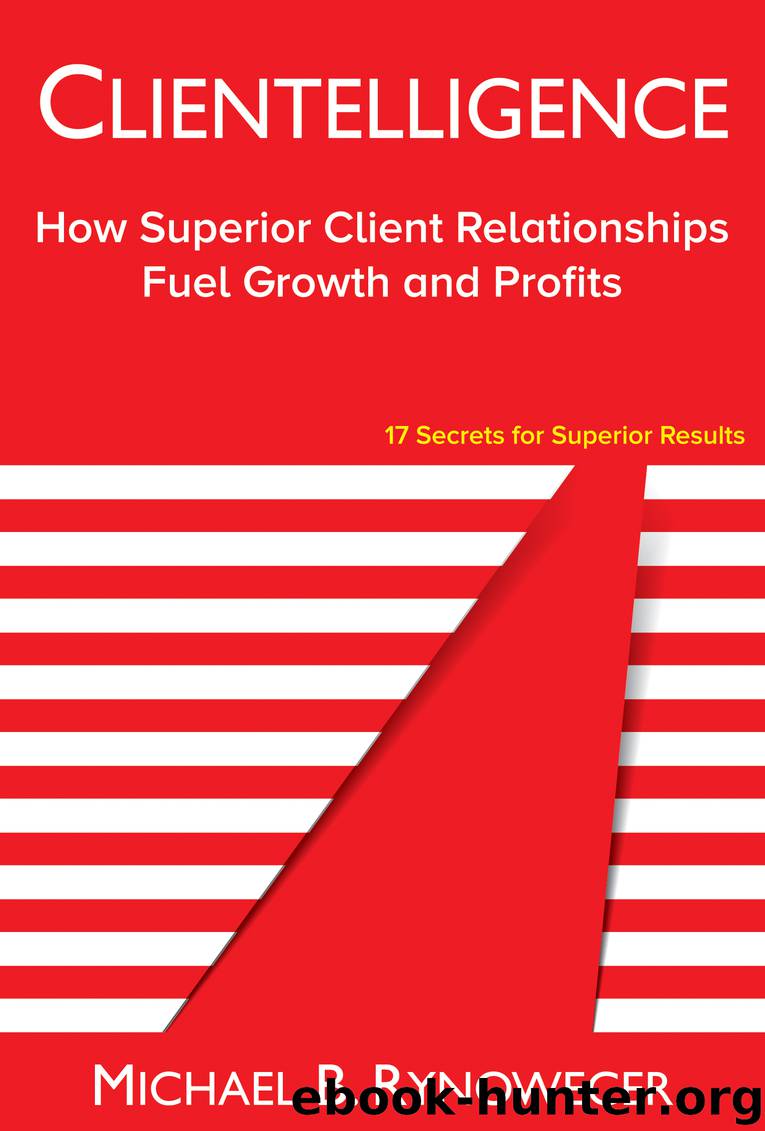Clientelligence by Michael B. Rynowecer

Author:Michael B. Rynowecer
Language: eng
Format: epub
Publisher: The BTI Press
Published: 2015-07-07T14:05:30+00:00
Pulling It Together:
Leverage the Quadrants to Differentiate Expected Activities
Be solution-oriented, not solution-focused.
Failure to include the client in the final decision on how to rectify the problem could potentially undermine your relationship. C-level executives continually tell me one of the top issues driving them crazy is when a professional services provider makes a decision without their authorization.
Save the story-telling for happy hour.
Cliffhangers and drawn-out woven tales of intrigue. No one has time for the story of how a problem came to be. C-level executives are looking for immediate, succinct communication regarding a problem. No sugar-coating, no slow dancing around the issue. State problems in a clear, concise manner. The sooner solutions are discussed, the better. Immediacy gives clients the opportunity to manage their own internal organization. Problems—particularly ones impacting scope or budget—have a funny way of finding their way to the CEO or CFO.
Take the bullet and move on.
Blame. This is a topic of great interest in the business world. We know it is unprofessional to assign blame for a problem, so a new word was created to make it more digestible: accountability. “I don’t blame you, but I hold you accountable.”
Issues need to be owned in the business world. We know the reason why something failed. It’s how we ultimately improve processes and weed out ineffective ideas (and sometimes individuals). However, the time to assign “accountability” is not in the heat of facing a problem.
We can only work towards solutions after there is ownership of a problem—so take ownership immediately—yes, you—to start the problem-solving process. (We’ll discuss how to ensure the problem doesn’t stick to you in a moment.)
Be detailed about the impact—not the problem.
C-level executives do not have the patience to listen to an entire saga of how a problem came to exist, but they do want to understand exactly how the problem will affect them professionally and personally. In short, what’s the damage assessment? Be prepared to openly and honestly discuss how the problem impacts:
Budget
Timing
Outcomes
Organizational perceptions
Risk exposure
Download
This site does not store any files on its server. We only index and link to content provided by other sites. Please contact the content providers to delete copyright contents if any and email us, we'll remove relevant links or contents immediately.
Bad Blood by John Carreyrou(6581)
Rich Dad Poor Dad by Robert T. Kiyosaki(6507)
Principles: Life and Work by Ray Dalio(6296)
Playing to Win_ How Strategy Really Works by A.G. Lafley & Roger L. Martin(6077)
Management Strategies for the Cloud Revolution: How Cloud Computing Is Transforming Business and Why You Can't Afford to Be Left Behind by Charles Babcock(4546)
The Confidence Code by Katty Kay(4219)
Thinking in Bets by Annie Duke(4184)
American Kingpin by Nick Bilton(3813)
Delivering Happiness by Tony Hsieh(3394)
Project Animal Farm: An Accidental Journey into the Secret World of Farming and the Truth About Our Food by Sonia Faruqi(3189)
The Power of Habit by Charles Duhigg(3093)
The Tyranny of Metrics by Jerry Z. Muller(3026)
Brotopia by Emily Chang(3026)
Mastering Bitcoin: Programming the Open Blockchain by Andreas M. Antonopoulos(3009)
The Marketing Plan Handbook: Develop Big-Picture Marketing Plans for Pennies on the Dollar by Robert W. Bly(3005)
I Live in the Future & Here's How It Works by Nick Bilton(2958)
The Content Trap by Bharat Anand(2887)
Applied Empathy by Michael Ventura(2864)
Building a StoryBrand by Donald Miller(2862)
